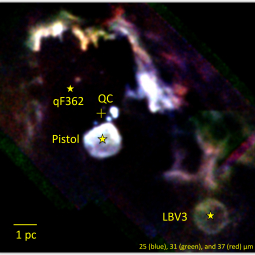Ryan Lau of Cornell University and his collaborators presented a poster paper analyzing SOFIA/FORCAST observations of mass loss from extremely luminous stars near the center of the Milky Way Galaxy during the 223rd meeting of the American Astronomical Society in Washington, DC.
Figure 1a below (taken from the Lau et al. poster) shows a mid-infrared image of a region around the Quintuplet Cluster located 35 parsecs (100 light years) from the Galaxy's nucleus. The position of the Quintuplet Cluster is indicated by the small cross and QC label.This image combines component images made at wavelengths of 25, 31, and 37 microns (represented respectively as blue, green, and red) using the Faint Object Infrared Camera for the SOFIA Telescope (FORCAST; P.I. Terry Herter, Cornell) during SOFIA's Early Science (2011) and Cycle 1 (2013) observing programs. The FORCAST camera is the red cryostat shown in Figure 1b, mounted on SOFIA's telescope. Note that radiation at those three wavelengths is completely blocked by Earth's atmosphere, and no currently operating space telescope has a mid-IR camera. Thus, SOFIA is uniquely capable of making these measurements.
The targets of these observations are nebulae (clouds) of material expelled from two massive stars known as the Pistol Star and LBV3 that are nearing the ends of their lives. These are among the most luminous and massive stars in the Milky Way, with 100,000 to 500,000 times the power output of our Sun and about 100 times its mass. They are members of a rare class called Luminous Blue Variable stars (LBVs) that have a brief evolutionary phase during which they lose mass at an enormous rate, ejecting a Sun's mass of gas every thousand years--an instant in astronomical terms. The oval blobs in Figure 1 labeled "Pistol" (center-left) and "LBV3" (lower right) are prominent nebulae of such material flowing away from the source stars in their respective centers (positions marked with star symbols). The nebulae are both about 4 light years in diameter.
Figure 2 (from Lau et al.) represents, from left to right, the sequence of events leading to the production of these LBV mass-loss nebulae. First, an LBV star in a late evolutionary stage has an "eruption" in which its ongoing stellar wind flow rate is temporarily enhanced by a factor of 100. Second, the out-flowing gas is dense enough to form an opaque shell that we outside observers see as an opaque shell with a temperature of 7000 K, surrounding and hiding the hot central star. Last, as the gas travels farther from the central star it becomes cool enough for tiny solid grains of silicon, carbon, and other elements to condense. The gas and grains will become part of the interstellar medium, and be recycled into future generations of stars and planets.
The Lau et al. paper compares and contrasts detailed properties and structure of the Pistol Star's nebula, significantly affected by radiation and winds from stars in the Quintuplet Cluster, with LBV3's nebula, which is relatively isolated and expanding more-or-less unimpeded. This research addresses questions regarding why several large clusters of stars including these rare giants have formed recently in the Galactic Center region, exactly how much mass is lost in LBV eruptions, and how mutual interactions between neighboring stars affects their evolution.
SOFIA is a joint project of NASA and the German Aerospace Center (DLR). The aircraft is based at the Dryden Aircraft Operations Facility in Palmdale, Calif. NASA Dryden Flight Research Center manages the program. NASA Ames Research Center at Moffett Field, Calif., manages the SOFIA science and mission operations in cooperation with the Universities Space Research Association (USRA) headquartered in Columbia, Md., and the German SOFIA Institute (DSI) at the University of Stuttgart.
Nature vs. Nurture: Identical "Twin" Luminous Blue Variable Stars with Contrasting Nebulae
Ryan Lau (Cornell University), Terry Herter (Cornell University), Mark Morris (UCLA), and Joe Adams (Cornell University & SOFIA/USRA), 2014, AAS Meeting #223, paper #346.32
Download the poster (pdf, 7MB)
Points of Contact
Dr. Dana E. Backman
SOFIA Outreach
NASA Ames Research Center
Moffett Field, Calif.
650-604-2128
dbackman@sofia.usra.edu


